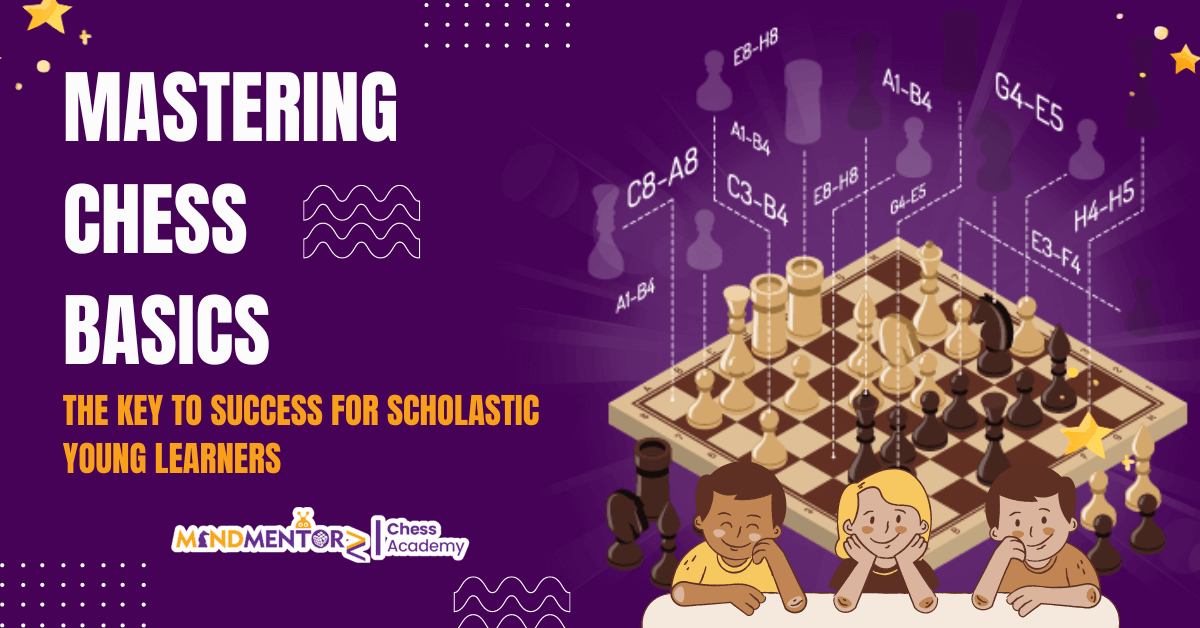
We believe that every child has the potential to become a chess champion. But where does the journey begin? Just like learning any new skill, mastering the basics of chess is the key to future success. Whether you’re 5, 10, or 16, knowing the foundations of chess will help you play with confidence and joy.
What Makes Chess Special?
Chess is more than just a game—it’s a way of thinking! Playing chess improves your focus, decision-making, and problem-solving skills. It’s like a gym for your brain. You might wonder, why should kids start with the basics? Well, no matter how exciting advanced strategies may seem, without understanding the core rules and moves, it’s hard to truly enjoy or master the game. Just like in cricket, where mastering batting, bowling, and fielding is necessary before you become a top player, in chess, it’s essential to understand the foundational rules and strategies first.
Understanding the Chessboard: Your Battlefield
The chessboard is like a battlefield. Every square has a purpose, and every piece has a role. The chessboard is made up of 64 squares—32 white and 32 black. Understanding this pattern is important for your success in chess.
Kids often find it fascinating when they realize that every square on the board has a name. Each square is identified by a letter and a number (like E4, D5, etc.). Knowing this will help you communicate your moves effectively with other players, and also when you start analyzing games or studying the moves of great players like Magnus Carlsen or Gukesh.
Meet Your Team: The Chess Pieces
Before we dive into tactics and strategies, it’s important to meet the team! Each piece on the chessboard has its own strength and weakness. Here’s a simple breakdown for young players:
Pawns: Pawns are your foot soldiers. They move forward one step at a time but can attack diagonally. Pawns may seem weak, but when used correctly, they can be very powerful—especially when they reach the other end of the board and transform into a Queen!
Rooks: Rooks move in straight lines across the board. They are your heavy-duty pieces and work best when they control open spaces.
Knights: Knights are special because they move in an ‘L’ shape. They can jump over other pieces, making them very tricky for your opponent to predict!
Bishops: Bishops move diagonally across the board, one stays on light squares, and the other on dark squares. They are your long-range attackers.
Queens: The Queen is the most powerful piece on the board because she can move in any direction—straight or diagonal. However, be careful, losing your Queen early in the game can make it very difficult to win.
Kings: The King is your most important piece. While the King can move one square in any direction, the game’s objective is to protect your King from being ‘checkmated’—a situation where your King is under attack and cannot escape.
Mastering the Rules: Step by Step
Once kids understand the pieces, it’s time to learn the basic rules:
Objective of the Game: The ultimate goal in chess is to checkmate your opponent’s King. This means putting the King in a position where it’s under attack and cannot escape.
How to Win the Game: You can win by checkmating your opponent, or if they resign. There are also draws, which can happen in different situations (like a stalemate, insufficient material, or agreement).
Special Moves:
- Castling: This move helps to protect your King and bring your Rook into play. You can castle only if neither your King nor your Rook has moved, and there are no pieces between them.
- En Passant: This is a unique pawn move that allows you to capture an opponent’s pawn as if it had moved only one square, under specific conditions.
- Pawn Promotion: When your pawn reaches the other side of the board, you can promote it to any piece, typically a Queen.
Tactics for Beginners
Once the rules are clear, young players should begin practicing basic tactics. Tactics are short-term strategies that allow you to gain an advantage during the game. Here are a few to start with:
- Forks: A tactic where one piece attacks two or more opponent pieces at the same time.
- Pins: A situation where a piece cannot move without exposing a more valuable piece behind it to an attack.
- Skewers: Similar to a pin, but in this case, the more valuable piece is in front and is forced to move, exposing a weaker piece behind it.
By learning these, young chess players can start to see patterns on the board and recognize opportunities to win material (like capturing your opponent’s pieces).
Practice Makes Perfect
At MindMentorz, we always tell our students that practice is the key to becoming better at chess. Just like how you practice math problems or practice your cricket shots, playing more games of chess and analyzing them will improve your skills. The more you practice, the more patterns you will recognize, and this will help you make better moves during the game.
How MindMentorz Helps You Grow
Whether you’re playing your first game or aiming to play in a tournament, MindMentorz is here to guide you. We provide personalized coaching, focusing on each child’s strengths and helping them overcome their weaknesses. We believe in making learning fun, and our coaches ensure that every child enjoys the process while mastering important concepts.
Conclusion
For every young player, learning the basics is the first step towards becoming a chess champion. With patience, practice, and guidance from MindMentorz, children aged 5 to 16 can enjoy the beautiful game of chess while developing life-long skills like problem-solving, concentration, and strategic thinking.
